
Scattered snow flurries. High 22oF. Low 12. On days like this I think about the challenges birds face outdoors.
Birds are outside in every kind of weather and have to cope with it — no matter what. It turns out that eating is the best defense against freezing to death. Food is the fuel they burn to stay warm.
The birds that stay in Pittsburgh in the winter are those who eat the kinds of food that are still available. Sparrows, cardinals and woodpeckers eat seeds, suet and dormant insects. Hawks and owls eat rodents and other birds. Starlings, crows and gulls eat anything, including garbage.
The colder it is, the more they have to eat to stay warm, In Winter World: The Ingenuity of Animal Survival by Bernd Heinrich I learned that “if [golden-crowned] kinglets go without food for only one or two hours in the daytime, they starve (and freeze) to death.” Birds burn up enormous amounts of calories to stay warm.
In the worst of winter I try to help the seed-eaters, and indirectly the hawks who eat them, by putting out bird seed. They are all grateful to have found an easy source of food. I have tried commercially made suet (animal fat with added bird seed) but it’s not popular with my avian visitors. Marcy Cunkleman makes her own suet from scratch and it’s a great success. You can tell by her photo of a plump red-bellied woodpecker at her feeder.
We humans are now largely insulated against the rigors of coping with cold. We have built permanent shelters and figured out how to use fire to heat them, whether directly through burning wood, oil or gas or indirectly by burning coal for electricity.
But I think our bodies have not forgotten our ancestral past when we lived outdoors all the time. As winter comes we eat more and cook more. No wonder the holidays are so replete with food. No wonder we eat so much and then vow to go on diets in the new year. Now that I understand how cold triggers eating, I know why those diets are so hard to accomplish in January.
(photo by Marcy Cunkelman)